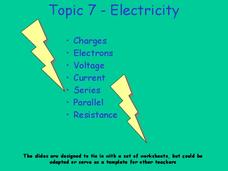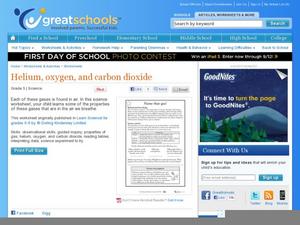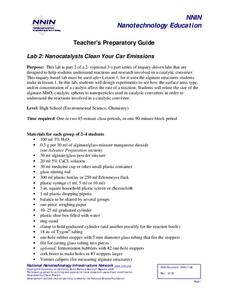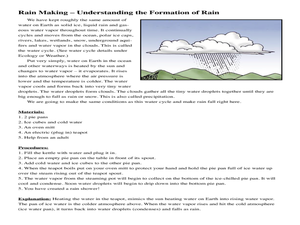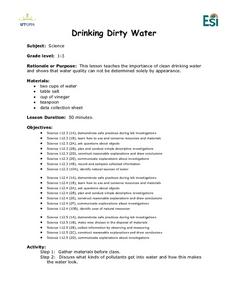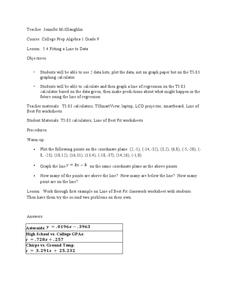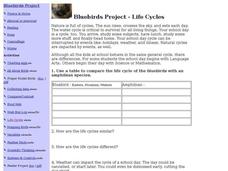Reed Novel Studies
Julie of the Wolves: Novel Study
Blood may not always be thicker than water. Julie, in Julie of the Wolves, soon depends on a wolf pack to be her family. Scholars read about Julie's adventures as they complete sentences with vocabulary words, answer comprehension...
Curated OER
Electricity
Each of these slides presents the basic scientific details and situations where charge, or static may appear. Handouts of the empty PowerPoint slides could be provided so that students could work through these examples and correctly...
Science Geek
The Mole
What can you call a tooth in a glass of water? A one-molar solution! Presentation covers moles, Avogadro's Number, calculating formula mass, converting moles to grams, converting grams to moles, and calculations with moles. It is...
Curated OER
Chilean Sea Bass
Introduce your mini-marine biologists to using databases. Tables of how many Chilean Sea Bass were caught and number of hours spent fishing are examined. Using the data, individuals calculate the "Catch per Unit of Effort" for each year....
Port Jefferson School District
Hurricane Katrina
Young scientists track Hurricane Katrina across the Atlantic Ocean as they learn about these destructive forces of nature. Provided with a table of data tracking the location and conditions of Katrina over a one week span, students...
Curated OER
Name That Gas!
Young scientists discover that air is a mixture of different gases - mainly nitrogen and oxygen. The properties of some of the other gases found in oxygen are listed in a table, then learners must decide which one of those gases is...
National Nanotechnology Infrastructure Network
Lab 2: Nanocatalysts Clean Your Car Emissions
Surface area certainly surfaces as a variable for chemical reaction rates. Scholars perform an experiment to discover how the size of catalysts affect the rate of a chemical reaction. They record their results in tables and graphs to...
Curated OER
Cleansing, Sparkling Koos
Students explore the importance of water conservation and investigate how plants clean water.
Curated OER
Volume of Irregular Objects
Fifth graders experiment using a Meniscus. In this volume instructional activity, 5th graders identify the volume of irregular objects using the process of water displacement. Students record data and draw conclusions.
Curated OER
Rain Making - Understanding the Formation of Rain
Students read and conduct and experiment to learn about rain formation. In this water forms lesson plan, students read about the formation of rain and its purposes. Students then complete a rain experiment activity.
Curated OER
Tree Bagging
Students bag trees to determine the mass of the water given off in the evapotranspiration process.
Curated OER
Up, Up, and Away
Learners create a model to explore the water cycle. Students also perform different experiments to witness water changing from a liquid to a gas. Learners are asked to if they can find ways for water to go away without pouring the...
Curated OER
Drinking Dirty Water
Students consider the importance of clean drinking water. They conduct a taste experiment with water, adding incremental drips of salt and vinegar to determine at which point it doesn't taste drinkable.
Curated OER
Fitting a Line to Data
Students work together in groups to collect data in relationship to how much water marbles can displace. After the experiment, they use the data to identify the linear equation to determine the best-fit line. They use the equation to...
Curated OER
Wat-er We Good For?
Fifth graders investigate the use of water as a resource that needs to be conserved. They practice the skill of water conservation by taking a home survey of water usage and modify the use in order to decrease the wasting of water.
Curated OER
On the Surface
Students draw and label the 15 major rivers in Texas. They then draw and label another map with the major lakes and reservioirs of Texas. Students use the maps and locate and label the location of the following major Texas cities:...
Curated OER
Do You See What I See?
Students hypothesize the role of rocks, soil, and water by observing a terrarium and create a model to explore the water cycle. This is part of a five station set up.
Curated OER
Numeracy Practice- Going Out For Lunch
In this math learning exercise, students complete the various types of activities that include graphs, data tables, and completing number sentences.
Curated OER
Sediment Deposition Lab
High schoolers set up a stream table, observe erosion, and record data on where various sizes of sediments settle. They draw conclusions as to what kind of sedimentary rock form in what locations.
Curated OER
A SALT WATER-Y WORLD
Young scholars observe a model of the distribution of the earth's water and compare the relative volumes and percentages of types of water on earth.
Curated OER
The Power of Ice
For this the power of ice worksheet, students conduct an experiment with freezing water by hypothesizing, following the four step procedure and writing a conclusion.
Curated OER
Bluebirds Project - Life Cycles
In this bluebirds worksheet, students complete a table and answer short answer questions about the life cycle of bluebirds. Students complete 1 chart and answer 5 questions.
Curated OER
Filling the Glass (Water, Air, and Fractions)
Students predict which of two glasses is 1/2 full using visual estimation, height measurement, and liquid measurement methods. Mathematical equations to accurately solve the problem are determined and verified.
Curated OER
The Affect of Water Temperature on Living Organisms
Students examine the environmental impact of global warming. In this environmental science activity, students design and conduct an experiment about the effect of temperature on paramecia. They write a lab report about their experiment.
Other popular searches
- Aquifer Water Table
- Water Table Diagram
- Water Table and Recycling
- Water Table Erosion Sand
- Sand and Water Tables
- Making a Water Table
- Science Water Table
- Soil and Water Table
- Water Table Activities
- Location of Water Table
- The Water Table

